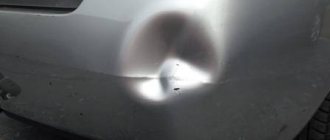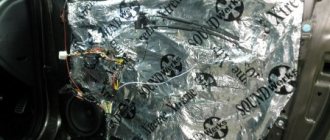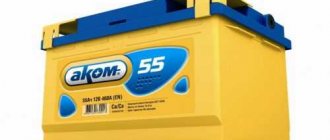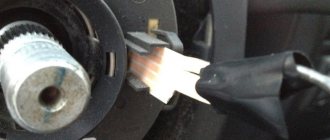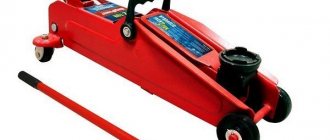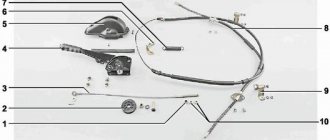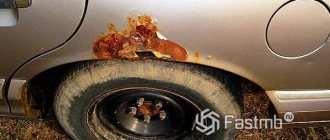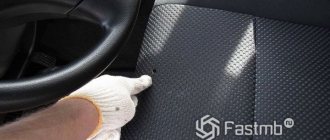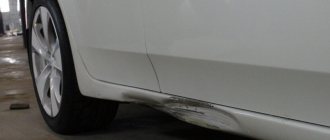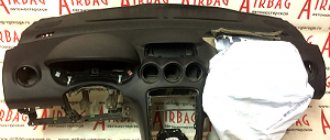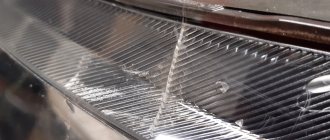Description of repair technology
The essence of the technology for carrying out body repairs using fiberglass is that the through hole is filled with an adhesive composition based on epoxy or polyester resin, and the fiberglass serves as a reinforcing element. In addition to the resin itself, plasticizers and fillers are often added, which increase the service life of this material and avoid premature cracking of the adhesive base, which is quite possible due to the loads that are placed on the body when the car is moving.
Preparatory stage of work
Before carrying out the main work, you will need to clean the surface of the damaged body from dust, corrosion and old paint. Usually, in addition to the hole itself, the area around it is also cleaned, the size of the indentation is about 50 - 60 mm. It is advisable to deepen the area where the work will be carried out a little so that the layer of filler and subsequent putty does not protrude from the general plane of the body part.
The next step is to clean the metal with sandpaper, degrease the surface, treat it with anti-corrosion compounds and primer.
Next, several patches are cut out of fiberglass, the size of the first should cover the through hole with an overlap of about 15 - 20 mm on the body. Subsequent layers of overlays should overlap the previous ones by exactly the same amount. If we say there are three patches, then the third patch should have a gap of 60 mm from the size of the through hole. This is done for high-quality fastening of the material and provides stronger reinforcement for the resin composition with which we will fill the damaged area.
Fiberglass installation process
After preparing the surface, we proceed directly to the work itself on restoring the body using fiberglass patches. We coat the cleaned area of the body at the joints with a resin-based adhesive, then take the first fiberglass varnish and press it to the surface. Using a roller or roller, roll out the glue under the patch to avoid bubbles. If there are any, they should be pierced and rolled out so that the surface is as smooth as possible and well glued to the car body. Next, we wait a little until the glue dries, and then apply a second layer of glue to the patch and body, again apply a larger patch and roll it out. Thus, all layers are applied until the plane is leveled.
The next stage is applying putty. Usually, to start, they take putty containing the same fiberglass and apply it in a continuous layer to the surface of the damage. Next, wait for it to dry, sand it using a machine and apply a layer of universal putty. Again, wait for it to dry and sand.
Next comes the process of applying primer, base paint and varnish. After which the part is polished.
It is worth noting that to repair large through holes on the back of the body, pads are used so that it is possible to work with fiberglass and it does not deform under pressure during the work. After puttying, this lining is usually removed.
This is what the process of doing a body repair using fiberglass yourself looks like. As you can see, there is nothing complicated here, and a minimal set of tools is needed.
Here is a video that will help you understand more clearly the technology of working with fiberglass in body repair.
Important point! Do not forget about safety measures when carrying out work. Thus, direct contact of resin or fiberglass on human skin can cause allergic reactions, and serious inflammatory processes in the eyes. Do not forget that fiberglass emits dust that is hazardous to the respiratory tract. So it is better to work in safety glasses, a respirator and rubber gloves.
Source
Additional actions
Additional actions may precede repairs or be performed during repairs. First of all, we are talking about leveling the hull of a small boat. If a hole or other damage occurs in a metal body, the area around it is usually characterized by the presence of a large dent that will need to be straightened using methods similar to those used to repair car bodies.
If a hole or damage occurs in a body made of composite material (fiberglass), then first of all you need to cut off the inevitable rags of fiberglass or glass mat sticking out around the hole. Indeed, during a strong mechanical impact, the polymerized epoxy in the body material crumbles in the form of small, often dusty, fragments, and the fiberglass, freed from the binder, breaks.
Holes in wooden cases are covered only with fiberglass, not glass mat. To do this, the integrity of the tree around the hole is assessed, the tree is drilled around, and the diameter of the drill is selected so that a jigsaw file can be inserted into the hole obtained from it. This will allow you to cut out a neat piece of damaged skin, then cover it from the inside with plywood 4-5 mm thick, screwing it to the body with small self-tapping screws, and fill the hole in the hole with epoxy from the outside. At the final stage, the filling layer is glued with fiberglass.
Description of repair technology
The essence of the technology for carrying out body repairs using fiberglass is that the through hole is filled with an adhesive composition based on epoxy or polyester resin, and the fiberglass serves as a reinforcing element. In addition to the resin itself, plasticizers and fillers are often added, which increase the service life of this material and avoid premature cracking of the adhesive base, which is quite possible due to the loads that are placed on the body when the car is moving.
Preparatory stage of work
Before carrying out the main work, you will need to clean the surface of the damaged body from dust, corrosion and old paint. Usually, in addition to the hole itself, the area around it is also cleaned, the size of the indentation is about 50 - 60 mm. It is advisable to deepen the area where the work will be carried out a little so that the layer of filler and subsequent putty does not protrude from the general plane of the body part.
The next step is to clean the metal with sandpaper, degrease the surface, treat it with anti-corrosion compounds and primer.
Next, several patches are cut out of fiberglass, the size of the first should cover the through hole with an overlap of about 15 - 20 mm on the body. Subsequent layers of overlays should overlap the previous ones by exactly the same amount. If we say there are three patches, then the third patch should have a gap of 60 mm from the size of the through hole. This is done for high-quality fastening of the material and provides stronger reinforcement for the resin composition with which we will fill the damaged area.
Fiberglass installation process
After preparing the surface, we proceed directly to the work itself on restoring the body using fiberglass patches. We coat the cleaned area of the body at the joints with a resin-based adhesive, then take the first fiberglass varnish and press it to the surface. Using a roller or roller, roll out the glue under the patch to avoid bubbles. If there are any, they should be pierced and rolled out so that the surface is as smooth as possible and well glued to the car body. Next, we wait a little until the glue dries, and then apply a second layer of glue to the patch and body, again apply a larger patch and roll it out. Thus, all layers are applied until the plane is leveled.
The next stage is applying putty. Usually, to start, they take putty containing the same fiberglass and apply it in a continuous layer to the surface of the damage. Next, wait for it to dry, sand it using a machine and apply a layer of universal putty. Again, wait for it to dry and sand.
Next comes the process of applying primer, base paint and varnish. After which the part is polished.
It is worth noting that to repair large through holes on the back of the body, pads are used so that it is possible to work with fiberglass and it does not deform under pressure during the work. After puttying, this lining is usually removed.
This is what the process of doing a body repair using fiberglass yourself looks like. As you can see, there is nothing complicated here, and a minimal set of tools is needed.
Body repair with epoxy resins before painting
The car body is entirely made of metal, therefore it is susceptible to corrosion processes that cause various damage. Small through corrosion damage is usually eliminated by soldering, medium-sized holes by welding, and large holes are covered with a steel sheet and soldered or welded on the inside of the body.
Obviously, such repairs can only be done by professionals and require special equipment - a welding machine. If soldering is used, it is better to use galvanized steel because it bonds more tightly to the solder.
Recently, car enthusiasts have been struggling with penetrating corrosion damage using epoxy resins and fiberglass. This repair method is very easy to learn, cheap and accessible to almost any car enthusiast, which is why more and more motorists prefer this method.
Body repairs using epoxy resins are carried out as follows.
The surface to be repaired is thoroughly cleaned of rust and dirt, sanded and degreased. To do this, you can use sandpaper, a grinder (grinder) or a drill with a special attachment. Once the area has been cleaned to shiny metal, it would be a good idea to treat it with a rust converter.
The shape and dimensions of the treated area of the body are determined by the area of corrosion. To this is added an allowance from the edges of the hole, which is at least 60 mm wide.
Next, fiberglass is taken, from which three overlays are cut out in the shape of the hole to be repaired, taking into account allowances. All three overlays differ from each other in size: the first should have an allowance from the edge of the hole of 20 mm, the second - 40 mm, the third - 60 mm.
Then the glue is prepared. To do this, mix 9-10 parts of liquid epoxy resin with one part of hardener. Fiberglass pads are impregnated with the finished glue and applied to the damaged area. Before this, the edges of the hole are also treated with glue.
When applying pieces of fiberglass, you need to make sure that each subsequent one overlaps the previous one by 20 mm on each edge. The top piece of fiberglass is covered with plastic film and pressed. When the resin has completely cured, you can remove the film.
After the surface to be repaired has dried, it is treated with a file and sandpaper. If small holes remain after the repair, they need to be sealed with putty.
When repairing large through holes, before laying fiberglass, a steel lining treated with a solution of polystyrene in acetone must be placed on the inside of the body.
This is necessary to prevent deformation of the piece of fiberglass. Once the epoxy has cured, the liner can be removed.
As you can see, car body repairs can be relatively easy and very affordable both in price and in terms of the necessary materials and equipment.
Source
Cold methods of sealing holes in thresholds
Depending on the degree of damage, a cold or hot repair method is selected. The cold method includes body work that does not require welding equipment. A small hole can be sealed:
- construction putty;
- using fiberglass;
- primer and secured with moldings.
The semi-hot method involves using a soldering iron to seal small holes.
How to fill a hole with fiberglass
The easiest way to repair a hole in a car sill without welding is to use a fiberglass patch. For repair you will need:
- The two fiberglass patches are 2cm larger than the corrosion area. Fiberglass or fiberglass can be used.
- Automotive primer, degreaser.
- Sandpaper, grinder for preliminary cleaning of the surface.
- Putty knife.
- Varnish, paint.
Self-repair takes up to 1 hour and does not require special skills, you need:
- Use a grinder to remove the old paint layer.
- Clean the threshold, if rusty dents or through holes are found, treat with a degreaser.
- The dents should be primed well and the material should dry completely.
- Cut out the fiberglass pads, place them on a dry surface, and secure them with adhesive and epoxy resin.
- After drying, the surface is primed, sanded and painted.
When using fiberglass, it is recommended to additionally secure the thresholds with moldings.
Filling holes with putty
It is recommended to restore thresholds with putty in the following cases:
- In the absence of large through holes.
- If moderate pockets of corrosion are observed that have not affected the geometry.
- For primary rust.
Sealing thresholds using this method is quite simple; repairs take up to 2 hours and do not require special skills, but you must have the necessary tools and material. For repair you will need:
- construction fiberglass and automotive standard putty;
- Bulgarian;
- aluminum mesh if you have to patch a significant but only hole;
- medium abrasive sandpaper from 800 grit;
- medium spatula;
- degreaser;
- automotive primer;
- paint, varnish.
Starting repairs requires preliminary preparation of the surface, for this you need:
- Clean the threshold from old paint by cutting off the layer of waste material with a grinder.
- Sand the surface and treat with degreaser.
- If the threshold does not have through holes, aluminum mesh is not used. If a significant deep focus of corrosion is discovered, cut out a patch of the required size from the mesh and apply it to the recess.
- Cover the mesh with construction putty. If the damage is minor, apply a layer of putty, leveling the composition. Let it dry.
- Sand and apply a thin layer of automotive primer.
- After drying, clean the area with sandpaper.
- Paint over, varnish.
The option of sealing holes with construction putty is often used when repairing a body, but experienced drivers do not recommend it, since it begins to dry out after 7-9 months, allows moisture to pass through, and corrosive destruction continues.
Cold welding method
The method is suitable for sealing small holes in thresholds, when there are no large pockets of rust and the internal metal, threshold amplifier, is not damaged. For repairs you will need polyester resins for body work, i.e. epoxy. Repair process step by step:
- Holes are cleaned with emery, a grinding wheel, and degreased.
- The resin is diluted in the required proportions or a ready-made composition is used.
- Fiberglass of the required size is impregnated with resin and glued to the hole.
- After drying, the surface is primed, sanded and painted.
This method is suitable for repairing those parts of the body that do not experience stress. If this method is chosen for thresholds, it is recommended to always install metal moldings.
Repair by sealing the hole with metal
Metal patches and subsequent soldering are considered the most productive means for restoring thresholds, even with a large area of corrosion. If rust has not led to deformation of the central pillars and distortion of the geometry, then you can use metal patches and strengthen them with a soldering iron. For repairs you will need the following materials and tools:
- metal patch, size 2 cm larger than the corrosion hole.
- assembly hammer;
- Bulgarian;
- medium abrasive sandpaper;
- anti-gravel;
- anti-rust composition - phosphoric acid, if available;
- soldering iron, tin solder;
- automotive primer, degreaser.
Preliminary work begins with treating the surface with a grinder after the used paint layer has been cut off; for this you need:
- Clean the thresholds and identify areas of corrosion.
- Cut from metal, you can use cans of auto chemicals, patches of the required size.
- Service the edges of the patch and treat the threshold with a degreaser.
- Solder the patch using a continuous seam.
- If the metal protrudes above the surface of the body, press the bubble with a hammer.
- Treat the dent in the metal with a primer, leveling the entire surface. Use phosphate primer for the first layer. After 10 minutes, apply standard automotive grade.
- Let it dry. Sand, apply a layer of paint and varnish.
Experienced drivers recommend not applying paint to the thresholds immediately after repairs, but treating the surface with a layer of anti-gravel and painting within 7-8 days.
Epoxy repair technology
Fiberglass is needed to strengthen a damaged area of the body or internal components of a car. If necessary, you can add substances to the epoxy that provide even greater reliability of the connection - aluminum or steel (in powder form), talc, sawdust. There are also plasticizers (oils and others) on sale that are added to epoxy to improve its properties. The plasticizer helps the resin not to peel and crack for a long time, which is why it is desirable for use.
Preparatory work
To prepare the product, clean it from any surface and deep contamination. Remove paint, corrosion, and dirt by wiping with solutions, washing, and sanding. Around the site of damage you need to treat the surface to 6 cm, no less. If you move the repair area a little inward, the overlay will hardly stand out from the main background. Before work, the area is degreased. If necessary, apply polish, anticorrosive or galvanizing. Then priming is done.
Glass material overlays are prepared according to the shape of the defect. You need 3-4 of them, which depends on the thickness of the fiberglass. The first should be 2 cm larger at the edges than the defect, the last should be 6 cm larger, and the intermediate ones should be 3-4 cm larger.
Installation of fiberglass overlays
First, a layer of epoxy diluted with a hardener is applied to the treated base. Next, the order of work will be as follows:
- apply the smallest piece of fiberglass, roll it with a roller to remove air,
- if air nevertheless penetrates under the material, the latter is carefully pierced,
- apply another layer of resin, layer the next medium-sized piece,
- if necessary, perform another intermediate layer or apply the largest “patch”, alternately wetting it with epoxy resin.
Pieces of fiberglass can be immediately impregnated with resin and applied to the intended place. The main thing is that each next layer overlaps the previous one by a few millimeters. After the resin has completely hardened, it is passed over the surface with a file, then it is sanded. The remaining holes can be covered with auto putty. For large holes, first place a hard patch - made of metal or plywood. This will help prevent damage to the fiberglass. The material is first lubricated with wax or paraffin so that it can be removed upon completion of the work.
Safety precautions
Do not allow epoxy to come into contact with the skin or eyes, which can cause allergies or toxic damage or inflammation. To do this, wear gloves and glasses. You need to work in a respirator, because small particles of fiberglass are also harmful to the respiratory system, as are resin fumes
It is important to install a good hood in the room or thoroughly ventilate it through a window. If resin gets on the skin, wash it well with soap and apply a nourishing cream.
Compliance with such measures will help to do the work efficiently and safely for health.
Fixing pinholes
When diagnosing a car, if there is a pinhole from corrosion on the threshold, in 80% of cases it is necessary not only to repair the hole, but also to change the amplifier. A full inspection will reveal large areas of rusty metal under a layer of paintwork. If a pinhole occurs from mechanical damage, then it is not associated with natural wear of the metal, so small holes are sealed using putty or soldering.
Soldering is carried out according to the same algorithm as sealing a hole with a sheet of metal, the only exceptions being the small size of the patch.
Use of soldering
If small holes in the threshold or bottom of the car are sealed with soldering, then simple tips will help:
- For heating metal more than 0.5 mm thick, household soldering irons are of little use. It is better to use a portable gas burner that has a small cylinder from 400 to 700 ml. The work will go faster.
- To solder thresholds you need solder and flux. For solder, a composition with lead or tin is used; the flux can be replaced with electrolytic acid.
Experts recommend not using soldering for body work at all. The main reason is that solder, tin or lead have a much lower electrical potential than iron; during their contact, electrochemical corrosion occurs, which can subsequently lead to full-fledged rust at the joints.
The second disadvantage of soldering is hot work, which is carried out in a safe place and as carefully as possible.
Repairing large-scale damage
Any hole in the threshold of a car indicates the beginning of corrosion, but what to do if the destruction of the metal is large-scale and simple means cannot be avoided? In this case, a gas welding machine is required, a complete digestion of the body, and sometimes a complete replacement of parts of the bottom and wings.
Superficial repairs using putty, fiberglass, and small metal patches will not change the situation dramatically; rotting of the body will continue.
Many car enthusiasts are faced with the problem of minor body repairs, when they do not have enough funds to contact a specialized car service or they want to carry out all the work themselves. If earlier owners of used cars, whose age was estimated at tens of years, thought about this issue, then with modern traffic density, auto repair threatens even relatively new vehicles. The fact is that you have to fight not only with local areas of rust on the body. The sharply increased number of minor accidents also puts new cars at risk.
Which epoxy resin should you use for car repairs?
Many car enthusiasts are faced with the problem of minor body repairs, when they do not have enough funds to contact a specialized car service or they want to carry out all the work themselves. If earlier owners of used cars, whose age was estimated at tens of years, thought about this issue, then with modern traffic density, auto repair threatens even relatively new vehicles. The fact is that you have to fight not only with local areas of rust on the body. The sharply increased number of minor accidents also puts new cars at risk.
Epoxy resin acts as a suitable and affordable means for auto repair. There are no strictly established instructions for its use, but there are plenty of life hacks on the Internet where epoxy is used. Later we will tell you which brands of resins are suitable for this purpose. But since fiberglass is an indispensable component when working with epoxy resin, you should first pay attention to this composite material, describing its features and properties.
Features of fiberglass
Fiberglass is another name for fiberglass; it is a unique material of its kind, consisting of several components. Fiberglass is sold not in the form of a monolith, but in the form of a substance consisting of many fibers. This material is quite durable and, at the same time, light and elastic. Fiberglass is made from epoxy resin and fiberglass, which is the main material for the production of bumpers, fenders and some other elements of the car body.
The use of fiberglass made it possible to reduce the weight of the machine, especially since it has a number of advantages over conventional plastic and metal.
The metal is very heavy, and this entails increased fuel consumption. Over time, metal elements corrode. An irreversible process leads to replacement of the unit, but if the source of corrosion is identified at its initial stage, then repairing the body with epoxy resin and fiberglass will significantly save the budget. Regular plastic is very fragile. The lack of elasticity allows it to be used only for interior decoration. By the way, epoxy can be used to repair not only fiberglass products, but also metal ones.
The production of glass fiber, which is based on epoxy resin, can be carried out in one or two phases. In a one-step production process, glass fibers are drawn from the glass mass. The two-stage production begins with the production of glass beads, which are subsequently converted into fiberglass. The final stage of these technologies is common. On it, the fibers are impregnated with epoxy and the finished material is obtained.
Fiberglass has a number of advantages that make it possible not only to produce parts for cars, but also to repair them. Lightness and strength have already been mentioned, but the advantages do not end there.
- Moisture resistance. When fiberglass is used correctly, the metal underneath will not rust.
- Thermal insulation. Due to its low thermal conductivity, fiberglass has an additional energy-saving function.
- Easy to use. Even without special skills, a car owner can independently repair a car’s bumper, hood, door or threshold.
- Wear resistance. Fiberglass parts are used in difficult weather conditions; they withstand changes in temperature, humidity, as well as the effects of reagents that are used to sprinkle roads in winter.
- Price. Saving money when carrying out auto repairs.
Production
Epoxy resin-based fiberglass for repairs is manufactured in one or two stages.
In the first case, the material is drawn from the glass mass. The second involves first forming glass beads, and only then obtaining fibers in parallel with which an epoxy mixture is added to the composition.
The second method is more complex and takes more time, but at the same time, it makes it possible to obtain a repair product of higher quality and with better properties.
Repair of metal components
Epoxy resin for a car will allow you to cope with pockets of corrosion on body parts. The degree of damage may vary, but the car owner must understand that the larger the area of the source, the more difficult it is to carry out repair work. Fiberglass in epoxy cannot replace metal in strength, so it is only possible to repair those areas that are not load-bearing.
Particular attention should be paid to metal preparation. Rust should be removed using phosphoric acid (rust converter) and a wire brush. The cleaned surface is degreased and coated with a primer. If these procedures are neglected, moisture will get under the fiberglass patch and the metal will begin to rust again.
The principle of repair is that glass fabric impregnated with resin is applied to the source of corrosion, even if through holes have appeared. Depending on the condition of the metal, several layers may be required. After the resin has cured, the patch is cleaned with sandpaper, degreased and primed again. After this, you can begin applying putty to create a relief and level the surface.
Body painting work must be carried out in a special chamber with sophisticated equipment. But some life hacks from experienced craftsmen will allow you to seal holes and paint areas of corrosion even at home.
How to glue with your own hands?
There may be several damages, and repairs will depend on the severity of the problem.
Crack
Repairing fiberglass is not particularly difficult if the process technology is followed. Once the edges are sanded, the part is placed on a flat surface and the edges are butted together to allow the exact size of the patch to be obtained. Some craftsmen prefer to leave the edges raw, believing that the patch will adhere more tightly.
If you clean the surface in the direction of damage up to 5 cm, you can get a perfectly smooth product. The crack and the area adjacent to it with a distance of about 10 cm must be sealed with polyester resin. Then the area covered with resin is covered with glass cloth grade 300. Then you need to wait for the resin to dry completely and apply a layer of putty. After all layers have completely dried, final sanding is done with sandpaper or a sander.
Hole or fracture
Reconstructing the resulting hole will take more time than repairing cracks. In this case, a patch is applied, taking into account that it is necessary to immediately prepare more fiberglass and putty. The damaged surface is cleaned in the same way as in the case of a crack. After stripping, tape is glued to the wrong side, then resin is applied to it and at a distance of 20 cm around it.
Repair of fiberglass body parts
Fiberglass has proven itself to be a reliable and practical material. Many automakers make from it not only decorative elements, but also non-load-bearing parts of the body (fenders, hood). Such elements are not subject to corrosion, but they have to be glued together or cracks repaired even more often than metal ones. Repair is advisable in the sense that even with significant damage, it is possible to restore the element to its previous shape.
Fiberglass impregnated with epoxy resin will retain its original shape. If you have a suitable matrix, you can independently produce body parts. However, such a matrix is difficult to produce, so many owners who decide to rely on their own strength restore parts “by hand,” allowing for significant errors.
Here, aesthetics are compensated by a small repair budget, which is why the use of epoxy in working with fiberglass still remains popular.
The work algorithm remains virtually unchanged. In exactly the same way as for metal structures, a patch is made from fiberglass. But when restoring a damaged part of a part, this patch is given a certain shape. The advantage of the material allows the frozen frame to be processed, puttyed and painted. Experienced craftsmen do this so skillfully that the result does not always differ from the factory stamp.
Epoxy polish
Epoxy resin is used not only in repair, but also in preventive work. All motorists are well aware that the paintwork becomes cloudy over time and becomes covered with small scratches. The entire aesthetic appearance of the car depends on it, so many people try to protect the thin layer of varnish in every possible way. Special polishes are created based on epoxy, which reliably protect body paint from sunlight and from small particles that cause chips. In addition, the resin gives additional shine to the surface of the body. Examples of such polishes are compositions from brands such as Wurth or Cilajet.
Manufacturers assure that the protective layer will perform its function for 1.5 years, but practice shows that after just a few months the parts need to be re-processed. The reliability of the epoxy layer, as well as its durability, depends on compliance with the application technology. But you should also take into account the nature of the vehicle's operation. The instructions for use indicate the basic requirements necessary for mandatory implementation.
- The polish must dry completely after application. This may take about a day.
- When carrying out work, it is necessary to observe the temperature regime. The temperature should be no lower than 15°C and no higher than 25°C degrees.
- Do not polish the car body in hot sunny weather. If possible, the car is driven into a clean box.
- The surface of the body parts on which a layer of epoxy is applied must be prepared. No dust, dirt, unevenness or scratches are allowed.
- Cars older than one year undergo additional treatment with abrasive materials before polishing.
- A layer of resin is applied to the degreased surface.
The difficulty of polishing with epoxy resin is that errors or violations of the technology cannot be immediately identified. They become noticeable after a short time. Following all the recommendations guarantees an excellent result, and the protection will last the entire allotted period.
Polishes are applied with special napkins, which are supplied complete with the main composition. The material is applied to the surface of the part and rubbed with a napkin in an even layer. The instructions indicate that you need to have time to lay the layer in 10-15 minutes. It must be taken into account that at elevated temperatures the polymerization time of the resin is reduced.
Application of epoxy resins in composite parts
Epoxy resin is a component of carbon fiber products. Carbon fiber (carbon) is a composite material consisting of carbon fiber and polymer resin (often epoxy). Carbon fiber reinforced plastics are characterized by high strength, rigidity and lightness. In the automotive industry, due to their unique characteristics, they have noticeably replaced traditional materials: steel and aluminum alloys. Composite materials are used in almost every component of a modern car. Most often they are made from:
- body elements, trunk doors, body panels, brake discs, sound and thermal insulation
- mounts for bumpers and radiators
- interior panels
- load-bearing structures of doors and seats, bottom elements
The reduction in vehicle weight as a result of the use of composite materials can reach 25%. This has a positive effect on fuel consumption and engine performance.
The areas of application of polymer resins in the automotive industry do not end there. Automotive design is constantly expanding the list of processes using epoxy resins. For example, parts for electric/hybrid vehicles, suspension systems, drive shafts, various types of vehicle support structures, etc.
Environmental Benefits of Epoxy Resins
Compared to alternative technologies, epoxy resins help reduce the overall environmental impact.
When using epoxy resins in the production process, emissions into the atmosphere and waste are significantly reduced. In addition, keeping vehicles running longer saves energy and raw materials, as well as reducing carbon dioxide emissions. Reducing vehicle weight through the use of composite materials reduces fuel consumption and operating costs, which also leads to reduced emissions.
The use of epoxy resins in other modes of transport
Epoxy resins are used not only in the automotive industry.
In railway transport, steel in gearbox housings and other parts is often replaced with composite materials. They reduce weight and increase service life by preventing damage from debris and corrosion.
Epoxy also provides excellent corrosion resistance, which reduces the need for boat repairs and maintenance.
In the aerospace industry, the use of epoxy resins helps reduce emissions, improve durability, efficiency, strength and reliability of parts. The weight savings achieved by using epoxy composites are estimated to reduce fuel consumption by approximately 230 million kg per year. This will save 139 million euros in fuel costs and reduce CO2 emissions from aircraft.
Overall, the European transport sector uses approximately 49,000 tonnes of epoxy resins annually. After the energy and construction industries, transport is the third largest consumer of epoxy resins in Europe.
The automobile industry currently employs 2.3 million people. Including Russia, Europe produces 19 million cars a year (about a quarter of global car production), resulting in a turnover of €500 billion. Each year, 5% of the €500 billion is invested in R&D (research and development), making the automotive sector the largest investor in research and development in Europe. It has been estimated that by reducing paint use by 1% through epoxy resin technology, European car manufacturers could save around €260 million per year.
Source
Epoxy anticorrosive
Areas most exposed to moisture and reagents are coated with a special anti-corrosion compound. The properties of epoxy resin allow it to be used as an anticorrosive agent. But epoxy anti-corrosion compounds differ from polishes. They should protect the car body not for several months, but for several years.
In addition to epoxy resin, the anticorrosive composition includes other substances, the list of which depends on the place of work. For example, for the underbody of a car it is recommended to use pastes containing wax and bitumen. The metal of the wheel arches is subject to constant bombardment of small stones, so rubber is added to the anti-corrosion compound. External body elements (lower parts of doors and sills) are treated with resin with aluminum powder or zinc paste. Almost all brands have one drawback - the likelihood of delamination at low temperatures. The applicability of such an anticorrosive agent depends on climatic conditions.
Materials
The modern master and car owner are provided with all the conditions for caring for their “iron horse”. In every city there are dozens of auto parts stores that sell various accessories, including automotive epoxy resins. The properties of polymers began to be used in car repairs long before the necessary materials became available for free sale. One can only guess what lengths car owners had to go to in order to get a fiberglass patch. It was necessary to separately purchase resin, fill it with the necessary components, and obtain fiberglass, which was previously considered in short supply.
Today there is no need to select a resin based on technical characteristics. Those models that are used in pouring work will not be suitable, and it is impossible to purchase epoxy, used in industry for the manufacture of glass and carbon fiber reinforced plastics, in stores. But manufacturers sell ready-made repair kits, which include the necessary resin, a certain amount of glass mat, and sometimes some tools.
It is known that resin can have different properties, depending on the presence of additives in it. Thus, the buyer has a choice of kits for sealing corrosion areas. The bumper repair kit, which includes epoxy resin and fiberglass, is only suitable for fiberglass, since the polymer requires slightly different characteristics for bonding to metal.
- Novol plus 710. One example of a car repair kit. It consists of epoxy resin in a 250 ml container, a hardener in a tube and glass mat. All materials are packaged in a compact and convenient tube that can be transported with you or stored in the garage. This kit is suitable for repairing bumpers, underbody, doors, as well as dashboards and other interior trim elements.
- EDP. Epoxy glue is considered universal. This means that its characteristics are averaged, so if you have fiberglass, which must be purchased separately, you can do auto repair.
- ED-20. A completely budget option, since the ED-20 model is known for its inexpensive cost. Professionals do not recommend using this resin for repairing metal parts of the body that experience stress (underbody) or provide appearance. But for sealing holes in the rust spots of a gas tank, such a resin is quite suitable.
- SEA- Line. Two-component composition and fiberglass under this brand are not so common, but many body repair specialists recommend this particular material. The kit includes a brush that is convenient for impregnating fiberglass. The hardener is poured directly into a measuring cup to make it easier to adjust the composition in the desired proportion.
There is probably not a single car enthusiast who has not at least once encountered the problem of damage to the body of his car. So how can you restore your car's former shine?
Today, there are a huge number of ways to repair a body, but one very simple, inexpensive, but reliable method of repair deserves special attention - restoring a car using fiberglass .
How to make body repairs with fiberglass (fiberglass) with your own hands
There is probably not a single car enthusiast who has not at least once encountered the problem of damage to the body of his car. So how can you restore your car's former shine?
Today, there are a huge number of ways to repair a body, but one very simple, inexpensive, but reliable method of repair deserves special attention - restoring a car using fiberglass .
Fiberglass (fiberglass) for body repair
Today, fiberglass is widely used in various areas of our lives. However, this material found its main application in the automotive industry. Fiberglass is simply irreplaceable when repairing a car body. This is due to its unique properties , such as:
- light weight;
- resistance to environmental influences and fire;
- simplicity and speed of installation;
- long service life - up to 50 years;
- and most importantly - its low cost.
Repairing a car using fiberglass is an inexpensive and uncomplicated method of do-it-yourself body restoration. It can be done by anyone, even a novice car enthusiast, in a garage and with a minimal set of tools. However, it is worth considering that restoring a car body using fiberglass is only possible if there is minor damage and in areas that are not load-bearing elements.
If the damage to the car is severe, then it is simply impossible to restore it using this method.
Preparatory stage
Preparatory work must be carried out with special care. It is necessary to clean the area of the part to be repaired from old paint and corrosion, so that not a drop of rust remains. After this, the surface to be treated should be sanded, dried well and degreased.
Proper preliminary work is the key to quality repairs.
Work technology
The most important conditions when carrying out work are consistency and unhurriedness . The repair procedure looks like this:
- patches are cut out of the material in shape and size corresponding to the damaged part of the body;
- epoxy resin and hardener are mixed in the prepared container in the proportions specified in the instructions;
- the first layer of the resulting mixture is applied to the prepared area;
- a prepared piece of fiberglass is placed on top and smoothed with a roller impregnated with resin;
- when the resin has set, the surface is covered with sandpaper;
- the next step is applying putty;
- After complete hardening, paint and varnish work is carried out.
Overlay installation techniques
First option
The area to be repaired is covered with polyester resin, and the first piece of fiberglass is applied. All formed air bubbles are expelled with a roller, and the remaining ones are pierced with an awl. They go over the surface with a roller; if necessary, the layer is compacted with an end brush. After this, the surface is again lubricated with resin, and the next layer of material is applied to it. So, one by one, all the layers are superimposed.
Second option
The cut patches are impregnated with resin. The edges are coated with glue. After this, the soaked pieces are applied to the damaged surface. The area being repaired must be completely closed. Each new layer must overlap the previous one by at least 20 mm. After the resin has completely hardened, they go over the surface with a file and sandpaper. The resulting irregularities are leveled using putty.
Features when working with large diameter damage
When restoring large-diameter holes, a lining is installed - a plywood sheet or a sheet of metal, it is also possible to use thick cardboard. This prevents the fiberglass patch from becoming deformed.
To prevent the lining from sticking, it is coated with polystyrene in acetone or wax mastic. The mastic mixture is prepared from wax and turpentine, mixed in a ratio of 2 to 1. This treatment makes it possible to easily separate the lining from the resin at the final stage of repair.
If it is difficult to get to the inside and the lining cannot be removed after the work is completed, then it is not installed.
In such cases, the damaged area is tightly stuffed with newspapers, in accordance with the shape of the body. At the very end of the renovation, the newspapers are removed.
How to install trims
There are 2 methods. Cover the area to be restored with polyester resin and apply the first piece of fiberglass. A small amount of air bubbles will form and will need to be removed using a roller. Those that remain can be pierced with an awl.
Walk over the surface to be restored with a roller. If necessary, thicken the layer using an end brush. Then lubricate the surface with resin again, apply a subsequent layer of fiberglass. Record everything in this order.
Repair and restoration of car seats
There is another way to restore the body. Treat patches made from fiberglass with resin and lubricate the edges with glue. Apply the impregnated fiberglass elements to the damaged surface.
It is necessary to completely close the area that you are repairing. It is important that each subsequent layer overlaps the previous one by about 2 cm. After the resin has completely hardened, you will need to go over the surface with a file and sandpaper. If unevenness occurs, it is recommended to smooth them out with putty.
The patch part is installed to the car body by soldering, i.e. welding work is performed using fiberglass adhesive. The areas where the part joins the cleaned body at the through hole are tinned. This allows you to create a good mount.
Next, a metal plate is applied to the damaged area of the body and an electric soldering iron is used. In this way the sheets are fastened. It happens that after such a restoration is performed, the soldered plate protrudes slightly beyond the body area. Then it is corrected with a cloth.
Safety measures during work
When carrying out repair work, it is imperative to use personal protective equipment: rubber gloves, safety glasses, a respirator.
The main danger during work is the contact of chemicals with human skin. Epoxy resin and hardeners can cause severe skin irritation. Also, resins and hardeners can cause allergic reactions. When grinding, dust may enter the respiratory tract. During the repair process, evaporation of resin, hardener and sanding dust can cause eye irritation.
How to restore a car body using fiberglass is shown in detail in the video.
- Author of the material
- Other materials
